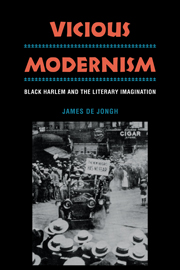Book contents
- Frontmatter
- Contents
- Acknowledgments
- Introduction: Vicious Modernism
- I The Legendary Capital: The 1920s and 1930s
- II The Emerging Ghetto: The 1940s and 1950s
- 5 The Emerging Ghetto
- 6 Go Tell It on the Mountain
- 7 Montage of a Dream Deferred
- 8 Negro de todo o mundo
- III The Inner City: The 1960s and 1970s
- Epilogue: Black Harlem and the Literary Imagination
- Appendix 1 A Checklist of Black Harlem in Poetry
- Appendix 2 A Checklist of Black Harlem in Novels
- Notes
- Index
5 - The Emerging Ghetto
Published online by Cambridge University Press: 05 February 2012
- Frontmatter
- Contents
- Acknowledgments
- Introduction: Vicious Modernism
- I The Legendary Capital: The 1920s and 1930s
- II The Emerging Ghetto: The 1940s and 1950s
- 5 The Emerging Ghetto
- 6 Go Tell It on the Mountain
- 7 Montage of a Dream Deferred
- 8 Negro de todo o mundo
- III The Inner City: The 1960s and 1970s
- Epilogue: Black Harlem and the Literary Imagination
- Appendix 1 A Checklist of Black Harlem in Poetry
- Appendix 2 A Checklist of Black Harlem in Novels
- Notes
- Index
Summary
A decade after Alain Locke's optimistic prophecies in “The New Negro,” Harlem was still a city of migrants, but no longer of refuge and hope. The legendary promise of refuge and cultural hope had been circumscribed by the evident deterioration of the fabled Negro enclave in the 1930s and 1940s, and the Harlem motif that bespoke a racial dream was becoming one more demonstration of denial. On March 19, 1935, barely one decade after the glittering debut of the New Negro renaissance, a rumor of the death of a juvenile shoplifter at the hands of police on 125th Street sparked a violent disturbance in Harlem, which, according to a subcommittee of the New York County Lawyer's Association, “surprised no one who has been in touch with the conditions under which we have permitted our Negro citizens to live.” A crowd began gathering at the store for news of the boy and grew angrier as one, then another, speaker denounced police brutality. The police ordered the crowd to disperse, but the arrival of an ambulance with a shrieking siren, followed by the coincidental appearance of a hearse, seemed to confirm the death of the boy and increased the hysteria. “The rumor of the death of the boy, which became now to the aroused Negro shoppers an established fact, awakened the deep-seated sense of wrongs and denials and even memories of injustices in the South,” stated The Complete Report of Mayor LaGuardia's Commission on the Harlem Riot of March 19, 1935.
- Type
- Chapter
- Information
- Vicious ModernismBlack Harlem and the Literary Imagination, pp. 73 - 81Publisher: Cambridge University PressPrint publication year: 1990



